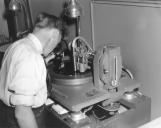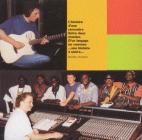26
Cutting records is a delicate operation that needs to be checked with a microscope.27
Technician cutting a recordOctober, 1948
Montreal, Quebec, Canada
 Credits:
Credits:Phonothèque québécoise collection
29
Tape recorders first appeared before the Second World War, but were perfected during the war. Wire bobbins were used, as seen on this model, followed by magnetic tape. The ability to edit opened new horizons to sound engineers, artistic directors and musicians. Multi-track recording was the next development. First 3 tracks could be recorded, then more, rendering production more flexible. In the more subtle forms of acoustic music (classical, jazz), it was not unusual to feature sound on 2 or 4 tracks in order to retain the spontaneity of the musicians and the integrity and beauty of the ambient acoustic environment.33
Portable device for listening to records1953
Montreal, Quebec, Canada
 Credits:
Credits:Phonothèque québécoise collection
34
Jean-Pierre Ferland in studioJanuary, 1964
Boulogne, France
 Credits:
Credits:Phonothèque québécoise collection
35
Access to studio time was significantly democratized. Digital recording made it possible to market more effective products at lower cost. It is possible today to produce a record at home. However, the experience contributed by a sound engineer, the ambient acoustics, the professionalism of the technicians as well as microphone quality and other elements that form part of a good sound studio are all factors that have a huge impact on the quality of a recording.37
David Gaudreault, guitarist, listening to his recording with Gilles Poirier, head of the SNE label.1990
Montreal, Quebec, Canada

38
Recording 'Petit fou' in Montreal with Gaston Bernard, Bill Garrett, and others.January, 2001
Montreal, Quebec, Canada






